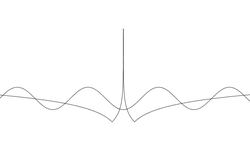Sign the log
 If
f
(
x
)
=
∣
ln
(
∣
x
∣
)
∣
−
2
and
g
(
x
)
=
sin
(
x
+
2
3
π
)
+
0
.
0
9
. Then find the total number of solutions of the equation
f
(
x
)
−
g
(
x
)
=
0
If
f
(
x
)
=
∣
ln
(
∣
x
∣
)
∣
−
2
and
g
(
x
)
=
sin
(
x
+
2
3
π
)
+
0
.
0
9
. Then find the total number of solutions of the equation
f
(
x
)
−
g
(
x
)
=
0
The answer is 16.
This section requires Javascript.
You are seeing this because something didn't load right. We suggest you, (a) try
refreshing the page, (b) enabling javascript if it is disabled on your browser and,
finally, (c)
loading the
non-javascript version of this page
. We're sorry about the hassle.
1 solution
Moderator note:
Other than knowing that h ( x ) = f ( x ) − g ( x ) is an even function. I'm curious to know whether it's possible to solve this without graphing.
Actually, I tried this problem without graphing and I did get a solution. I still used a calculator for a few values.
First, I noted the symmetry of the problem. Then, I went about solving for the number of intersections on the right side. I noticed that for every peak of g ( x ) , there would be two intersections of the graphs as long as f ( x ) < 1 . 0 9 , the maximum of g ( x ) (intuitively, trig peaks at one).
So I then set f ( x ) = m a x ( g ( x ) ) and simplified a bit for ∣ l n ( ∣ x ∣ ) ∣ = 3 . 0 9 . I'm currently only interested in what happens to the right, so from ± e ± 3 . 0 9 I used the value e 3 . 0 9 . This is the x -value where f ( x ) exceeds the maximum of g ( x ) .
Next, I find 2 ⌊ 2 π π + e 3 . 0 9 ⌋ for the number of peaks that g ( x ) reaches before this x -value, giving us 6 . However, I noticed here that a final two may exist that escape the reach of the max of g ( x ) while still intersecting it.
To address this, I found the derivatives of both sides and set them equal to each other, giving me x s i g n ( l n ∣ x ∣ ) = sin x . I did this because I knew that the derivative of f ( x ) would need to be less than the derivative of g ( x ) , then greater than the derivative of g ( x ) in order to intersect under g ( x ) , then escape before the max value. Here, I would have to sort of cheat and have my calculator solve this for values between 2 1 3 π and 2 1 5 π , which it does. I take this x-value and enter it for f ( x ) − g ( x ) , and get an astoundingly positive nonzero number, so I know there are two more intersections on the right than I previously thought.
I end up with 8 intersections on the right side, so I know that I will have 1 6 intersections total.
So really, the solve thing is a bit iffy, but it seems you can get pretty far without hopping to the graphing option.
Without graphing only four solutions are seen
Nice graph player i many time obserbed his solution by graph nice
The surest way to do this is by plotting the graphs of f ( x ) and g ( x ) and check the solutions. Using Newton's method it is found that there are 1 6 solutions as follows:
\[\begin{array} {} \pm 0.319613428 & \pm 5.17488463 & \pm 7.820756856 \\ \pm 10.71050396 & \pm 14.78521 & \pm 16.48571323 \\ \pm 21.91736565 & \pm 21.97375318 \end{array} \]